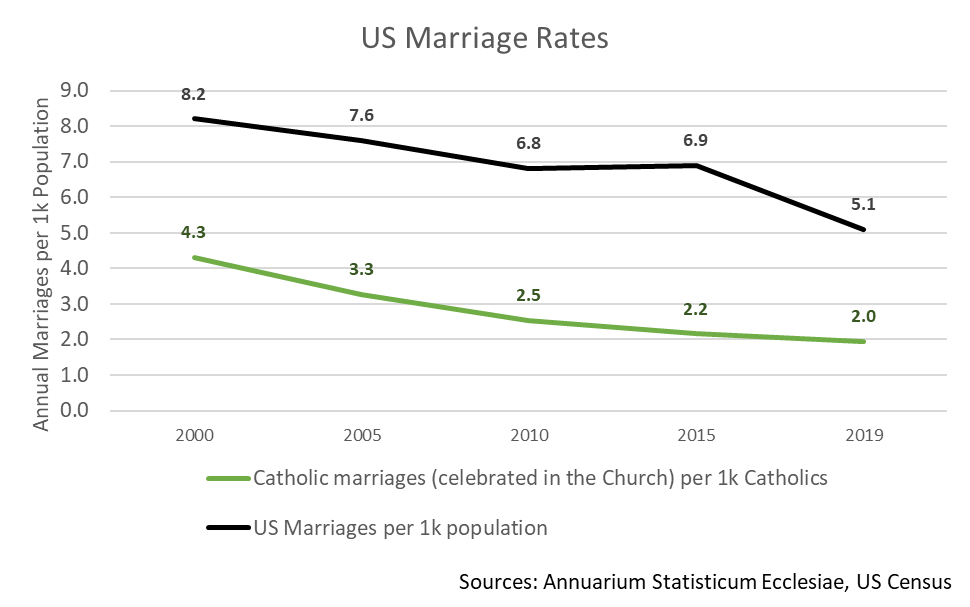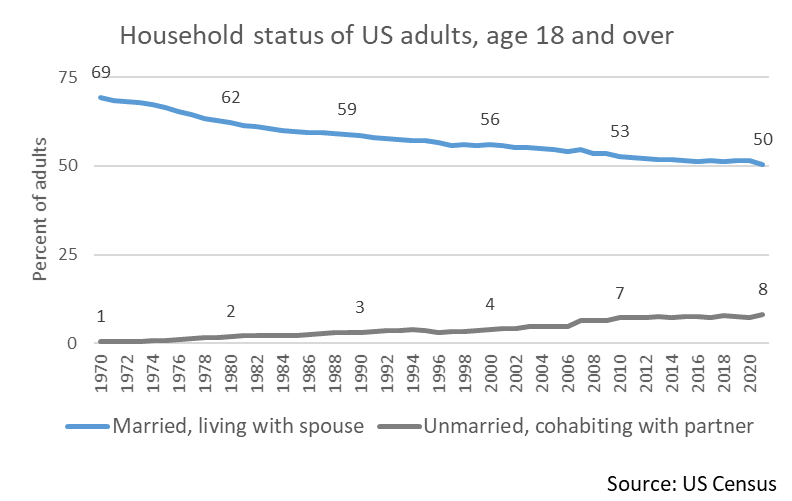
A newly released draft Vatican document calls for the creation of “catechumenate” marriage prep programs, which would provide for about a year of formation for couples anticipating marriage within the Church, along with additional years of support after marriage.
Assessing that proposal requires some sense of the state of marriages among Catholics. So The Pillar looks at the numbers:
The document
The Dicastery for Laity, the Family and Life released June 15 “Catechumenal Itineraries for Married Life,” a draft text published in Italian and Spanish,” with an introduction by Pope Francis.
In his introduction, the pope wrote that the document meets "the need for a ‘new catechumenate’ in preparation for marriage" — a need the pontiff said he has flagged before.
Describing difficulties the recommendations aim to address, Pope Francis wrote that:
“What emerged was the serious concern that, with too superficial a preparation, couples run the real risk of entering into a marriage that is null and void or has such a weak foundation that it ‘falls apart’ in a short time and cannot withstand even the first inevitable crises.”
The pope noted that the Church already devotes many years to the formation of candidates for the priesthood and religious life, and observes that in comparison the Church provides only a few days or weeks of active formation for couples approaching matrimony, which is a vocation of equal importance in the Church.
To fill this gap, the document prescribes a catechumenate of marriage, which Pope Francis described as follows:
“It is structured according to the three stages: the preparation for marriage (remote, proximate and immediate); the celebration of the wedding; the accompaniment of the first years of married life.”
The situation
The family is, according to the Church, the foundation of human society.
But while the number of Catholics in the world has increased 17% over the last 12 years, the number of marriages celebrated by the Church has decreased 26% over that same period of time, according to statistics released in the Annuarium Statisticum Ecclesiae.
Indeed, in every region of the world, the number of marriages celebrated within the Church has dropped in relation to the Catholic population between 2007 and 2019 — in some cases drastically.
In the United States, the number of marriages celebrated annually is decreasing among the population as a whole, but the number of Catholic marriages celebrated within the Church and according to the Church’s canon law is decreasing faster.
According to the Center for Applied Research in the Apostolate, in 2000 there were four marriages celebrated according to Catholic canonical form per 1,000 Catholics. By 2019, that number had dropped by half. Catholic canon law and theology do not recognize as valid those marriages contracted by Catholics outside of the Church’s required canonical form, with very few exceptions.
But the data does not mean that Catholics are less likely to get married, at least civilly.
Indeed, in a 2015 survey on marriage and the family, Pew Research found that 51% of Catholics report they are married, compared to 47% of the general population. That number includes those Catholics who marry outside of Catholic canonical form.
One reason for fewer marriages among Catholics is actually encouraging: Catholics are somewhat less likely to divorce. Pew found that 25% of Catholics have been divorced, as compared to 31% of the general population.
With nearly 50% of first marriages ending in divorce within 20 years, according to a 2012 National Health Statistics Report, a lower rate of divorces (and thus remarriages) leads to fewer overall marriages than the general population.
But another factor is that many Catholics do not marry within the Church. According to Pew Research, only 68% of civilly married Catholics were married within the Church.
Moreover, increasing numbers of couples are choosing not to marry at all, but rather to live together in cohabiting relationships. In the US, the percentage of adults living in married couples has declined from 69% to 50% since 1970, while the share living in cohabiting relationship has increased from 1% to 8%.
Among younger couples the trend is even more pronounced. Among US adults aged 25-34, the percentage living in married relationships has declined from 82% in 1970 to 38% in 2021, while the percentage who are cohabiting has increased from less than 1% to 17%
In some European countries these trends are even more dramatic. Nearly 40% of French couples aged 25-44 are cohabiting, while in Spain the cohabitation rate for couples in that age range is just under 30%.
And while divorce continues to be a problem among married couples, cohabiting relationships tend to be of even shorter duration than marriages.
So as Pope Francis and the Dicastery for Laity, the Family and Life contemplate the state of marriage within the Church today, they see before them the twin challenges of a situation in which a significant percentage of Catholics divorce, and also in which nearly a third of Catholics marry outside Catholic canonical form.
Analysis
It is certainly clear that there are problems with the state of marriage and relationships. And there are indications that a deeper practice of the Christian faith and integration into the Christian community can help couples avoid these pitfalls.
In a recent study highlighted by the Institute for Family Studies, researchers at the Harvard T.H. Chan School of Public Health found that couples who regularly attended religious services were more than 45% less likely to divorce than couples who do not. And although such results sometimes suggest to analysts that religious people may be more likely to feel compelled to remain in an unhappy marriage, the same study found greater levels of happiness among regular church attendees as well.
Other analysis conducted by the IFS suggested that couples who followed Catholic teachings on marriage and sexuality would be less likely to divorce. One found that couples who did not cohabit before marriage were about 20% less likely to divorce than similar aged couples who did cohabit before marrying.
Another study found that people who did not have multiple sexual partners before marriage had a 10% chance of divorcing within the first five years of marriage, while those who did have multiple sexual partners had a 20% to 30% chance of divorce within the first five years of marriage.
As the Church seeks to help couples live out happy and lasting marriages, these findings suggest that a foundation in both active religious practice and in Catholic sexual morality would be of help in couples preparing for marriage.
At the same time, accomplishing these goals through a marriage catechumenate may prove challenging, since the point when a couple is already engaged and preparing for a wedding may be rather late in the game to inculcate practices and beliefs.
It may well be that the best way to prepare couples for marriage is to prepare them and their families years before to live lives of active sacramentality within the Church, and to foster belief in the Church’s constant moral teaching.







